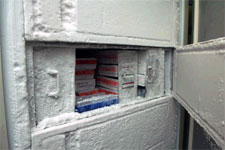Newly engineered enzyme is a powerful staph antibiotic
06 Feb 2010
With their best chemical antibiotics slowly failing, scientists are increasingly looking to nature for a way to control deadly staph bacteria - the culprit behind most hospital infections.
Naturally toxic for bacteria, enzymes called lysins have the promising ability to obliterate staph, but the problem is producing large enough quantities of them to study how they work.
 Rockefeller University scientists have now overcome this barrier by engineering a lysin that not only kills multidrug-resistant Staphylococcus aureus (MRSA) in mice, but also works synergistically with traditional antibiotics that have long been shelved due to resistance.
Rockefeller University scientists have now overcome this barrier by engineering a lysin that not only kills multidrug-resistant Staphylococcus aureus (MRSA) in mice, but also works synergistically with traditional antibiotics that have long been shelved due to resistance.
For the past five years, Vincent A. Fischetti, head of the Laboratory of Bacterial Pathogenesis and Immunology, and his colleagues have tried to clone a lysin that specifically targets staph, but they always ran into the same problem. Although hundreds of thousands of lysins could be expressed in an engineered cell, they all would stick together forming an insoluble clump, rendering them inactive. ''They were useless; a real thorn in our side,'' says Fischetti. ''We've come across some problems cloning lysins for other bacteria, such as strep, but nothing to this extent.''
Lysins, proteins derived from the viruses that have been infecting bacteria for billions of years, have two basic components. One acts as a recognition system to identify the specific bacteria species it has evolved to target; the other works like a molecular power drill that bores holes through the bacterium's cell wall, killing the organism. Together, these two components work so quickly and so efficiently that bacteria have no time to develop resistance.
To develop a functional lysin, Fischetti's team, including former postdoc Anu Daniel, and and senior graduate fellow in the labChad Euler, took advantage of the modular nature of lysins. In a series of progressive and logical steps, the team mixed and matched the two segments from 20 to 25 different staph-specific lysins until they created a chimera that, when expressed in sufficient numbers, didn't stick together. They then tested the chimeric lysin - named chimeric lysin for staphylococci, or ClyS - to see if it would behave like one that had evolved in nature.






















